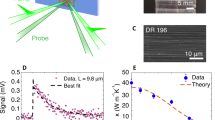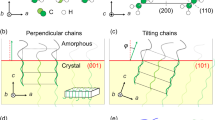Summary
The investigation is concerned with the origin of interfacial dislocation networks in polyethylene crystals, such as are indicative of crystallographic contact between overlying lamellae. Previously such dislocations were only observed under exceptional and undefinable circumstances. In search for an explanation, a wide range of polyethylene fractions have been investigated. It has been established that the ability to form interfacial dislocations depends on the presence of molecules whose length is only two or three times the thickness of the lamellae. Detailed correlations have been made between the degree of lamellar contact and molecular weight. Crystallographic contact is promoted by the number of molecular ends, but is suppressed if much material above about 15000 in molecular weight is present. New electron microscope observations reveal that interfacial dislocations can occur when the folded ribbons of the superposed layers cross. Considered in relation to the magnitude of theBurgers vectors of the dislocations, this shows that interactions between folds on the layer surfaces are not sufficient to explain the crystallographic contact between the layers. An alternative mode of contact is suggested: molecular ends can protrude from one layer and penetrate in some degree the lattice of an overlying layer. Two conditions are necessary for this model to be valid, a tendency for ends to be at the crystal surfaces, and crystal surfaces ‘rough’ enough to provide sites where ends can interpenetrate. Measurements made to check these conditions are reported in the following publication.
Zusammenfassung
In dieser Arbeit wird der Ursprung von Grenzflächennetzwerken an Polyäthylenkristallen betrachtet, so wie sie den kristallographischen Kontakt zwischen einander überlappenden Kristallen deuten. Bisher wurden derartige Fehlstellen nur unter besonders ungewöhnlichen und undefinierten Umständen beobachtet. Auf der Suche nach einer Erklärung wurde ein weiter Bereich an Polyäthylenfraktionen untersucht. Es ließ sich zeigen, daß die Fähigkeit, Fehlstellen in Zwischenflächen zu bilden, von der Anwesenheit von Molekülen abhängt, deren Länge nur das zwei- oder dreifache der Dicke der Lamellen beträgt. Detaillierte Korrelation wurde zwischen dem Grad des Kontaktes der Lamellen und dem Molekulargewicht hergestellt. Kristallographischer Kontakt wird durch die Zahl der Molekülenden hervorgerufen, bleibt jedoch aus, wenn viel Material mit Molekulargewichten wesentlich größer als 15000 anwesend ist. Neue elektronenmikroskopische Beobachtungen zeigen, daß Grenzflächenfehlstellen auftreten können, wenn sich gefaltete Bändchen von übereinander gelagerten Schichten kreuzen. Betrachtet im Hinblick auf die Größe derBurgers-Vektoren der Fehlstellen, zeigt sich, daß die Wechselwirkungen zwischen Falten auf der Schichtoberfläche nicht ausreichen, um den kristallographischen Kontakt zu erklären. Eine alternative Art des Kontaktes wird vermutet: die Molekülenden können aus der Schicht austreten und in gewissem Grad das Gitter der darüberliegenden Schicht durchdringen. Zwei Bedingungen für die Gültigkeit dieses Modells sind erforderlich, eine Tendenz, daß die Enden sich in den Kristalloberflächen befinden, und ferner, daß die Kristalloberflächen rauh genug sind, um freie Stellen für das Eindringen der Enden zu besitzen. Messungen zur Testung dieser Bedingungen werden in der folgenden Veröffentlichung mitgeteilt.
Similar content being viewed by others
References
Holland, V. F. andP. H. Lindenmeyer, J. Appl. Phys.36, 3049 (1965).
Agar, A. W., F. C. Frank, andA. Keller, Phil. Mag.4, 32 (1959).
Niinomi, M., K. Abe, andM. Takayanagi, Reports on Progress in Polymer Physics in JapanXI, 165 (1968).
Niinomi, M., K. Abe, andM. Takayanagi, J. Macromol. Sci.B2, 649 (1968).
Holland, V. F., P. H. Lindenmeyer, R. Trevedi, andS. Amelinckx, Phys. Stat. Sol.10, 543 (1965).
Bassett, D. C., Phil. Mag.17, 37 (1968).
Keller, A., Reports on Progress in Physics31, 623 (1968).
Sadler, D. M., submitted to J. Polymer Sci.A-2.
Bassett, D. C., Phil. Mag.10, 595 (1964).
Abe, K., M. Niinomi, andM. Takayanagi, Reports on Progress in Polymer Physics in JapanXI, 161 (1968).
Bassett, D. C., private communication.
Bassett, D. C., F. C. Frank, andA. Keller, Phil. Mag.8, 1739 and 1753 (1963).
Bassett, D. C. andA. Keller, Phil. Mag.7, 1553 (1962).
Khoury, F. andF. J. Padden, J. Polymer Sci.27, 455 (1960).
Sadler, D. M., Ph. D. Thesis, Bristol University 1969.
Blundell, D. J., Ph. D. Thesis, Bristol University 1967.
Peterson, J. M. andP. H. Lindenmeyer, J. Appl. Phys.37, 4051 (1966).
Odajima, A. andT. Maeda, J. Polymer Sci.C15, 55 (1966)
Teare, P. W. andD. R. Holmes, J. Polymer Sci.24, 496 (1957).
Author information
Authors and Affiliations
Additional information
With 17 figures in 18 details
Rights and permissions
About this article
Cite this article
Sadler, D.M., Keller, A. Polyethylene crystals with dislocation networks; their origin structure and relevance to polymer crystallization Part I. Kolloid-Z.u.Z.Polymere 239, 641–654 (1970). https://doi.org/10.1007/BF02085913
Received:
Issue Date:
DOI: https://doi.org/10.1007/BF02085913




